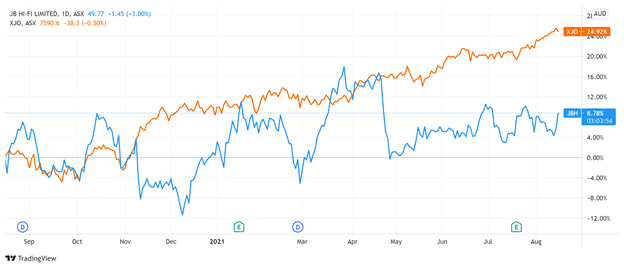The JB Hi-Fi Ltd [ASX:JBH] share price is in the spotlight after the retailer announced solid FY21 results.
At the time of writing, the JBH share price was up 3%, trading at 49.78 a share.
JBH shares have underperformed over the last 12 months, with the retailer gaining 5% in the period, while the ASX 200 benchmark gained 24%.
Can market sentiment shift on the back of today’s results?
Overview of JBH’s FY21 performance
It is important to look at the key financials to get a better idea of the fundamentals of JBH.
JBH reported total sales of $8.9 billion, an increment of 12.6% from FY20.
That said, online sales jumped 78.1% to $1.1 billion.
Combined with sales growth, JBH saw some operating leverage during FY21. This led to an EBIT increase from $483.3 million to $743.1 million, an increase of 53.8%.
All this led to a lift in Net Profit After Tax (NPAT). From $302.3 million in FY20, NPAT jumped 67.4% to $506.1 million in FY21.
Earnings per share also saw a healthy rise, with EPS up 67.5% to 440.8 cents per share.
The retailer’s final dividend was up by 18.9% to 107 cents, bringing the total dividend for FY21 to 287 cents per share, up 51.9%.
Incoming Group CEO Terry Smart was pleased with the performance.
‘On behalf of Richard and I, I would like to recognise and thank our team members across Australia and New Zealand who have worked tirelessly throughout this period and delivered another record result.
‘Our continued focus on the customer, combined with the strength and competitive advantage of our multichannel offer, be it in-store, online or over the phone, has enabled us to seamlessly meet our customers’ increased demand.’
Now, let’s break down FY21 trading performance across JB Hi-Fi Australia, JB Hi-Fi New Zealand, and The Good Guys.
JB Hi-Fi Australia
For JB Australia, total sales grew by 12% to $5.96 billion, with comparable sales up 13%.
Online sales contributed 13.1% of the total sales, growing 93% to $780 million.
Gross profit jumped 13.4% to $1.33 billion with gross margin up 27 bps to 22.2%.
Cost of doing business was 11.2%, down 91 bps on the previous corresponding period.
JBH said that its elevated sales growth, gross margin expansion, and disciplined cost control resulted in strong overall earnings growth.
EBIT for the Australia segment was up 33.6% on the pcp to $523.0 million, with EBIT margin up 142 bps to 8.8%.
JB Hi-Fi New Zealand
Total sales jumped 17.4% to NZ$261.6 million, with comparable sales up 17.4%.
A key contributor to the New Zealand sales mix was online, which grew 35.6% to NZ$27.6 million, or 10.6% of total sales.
Gross margins increased by 129 bps to 17.8% and CODB was 13.1%, down 109 bps on the pcp.
EBIT was NZ$5.8 million.
The Good Guys
Total sales grew by 13.7% to $2.72 billion, with comparable sales up 13.7%.
Online sales were up 48.5% to $258.3 million, which made up 9.5% of the total sales.
Gross profit was $608.6 million with gross margin up 189 bps to 22.4%, while the cost of doing business was 11.7%, down 100 bps as store wages remained well controlled throughout the year.
Finally, EBIT was up 90.2% on the pcp to $214.7 million, with EBIT margin up 318 bps to 7.9%.
JB Hi-Fi’s underperformance relative to the ASX 200 over the past 12 months follows Australia’s plunging into intermittent lockdowns to battle the Delta variant.
JBH shares fell nearly 15% through July and August on the back of lockdowns across Australia’s two most populous states — NSW and Victoria.
The retailer itself admitted that revenue at its Australian stores dropped 14.6% in the six weeks since the start of July.
Now, while online retailers like JBH and Kogan have benefited from earlier lockdowns last year, the circumstances are slightly different now.
For one, JobKeeper stimulus has ended.
And two, many people who rushed to purchase electronics last year are now already set up for remote work, putting a cap somewhat on new sales.
Despite the strong results today, analysts believe the lockdowns in NSW and Victoria will squeeze sales in 2022.
Analyst estimates suggest JBH’s net profit could fall to $410 million this year.
It looks like a lot will ride on Australia’s vaccination rate and the impact of the sustained lockdowns in Victoria and NSW.
That said, the pandemic uncertainty isn’t affecting all stocks equally.
In fact, as our technical analyst Murray Dawes pointed out this weekend, we are entering an ‘era of the small-caps’.
We are living through a time where technological advancements make barriers of entry easier.
Which in turn makes it easier for smaller, nimbler players to take on the big guns in industries that have seemingly been sewn up for decades.
As Murray and Ryan Clarkson-Ledward’s latest small-cap report says:
‘There are ALWAYS small companies developing new and disruptive ideas with the potential to change everything — not just for a single company, but for a whole industry (and sometimes even a whole civilisation).’
The trick for us as investors is how to go about finding them.
Their report aims to do just that. If you want to check it out, you can do so here.
Regards,
Lachlann Tierney,
For Money Morning
PS: Our publication Money Morning is a fantastic place to start on your investment journey. We talk about the big trends driving the most innovative stocks on the ASX. Learn all about it here


